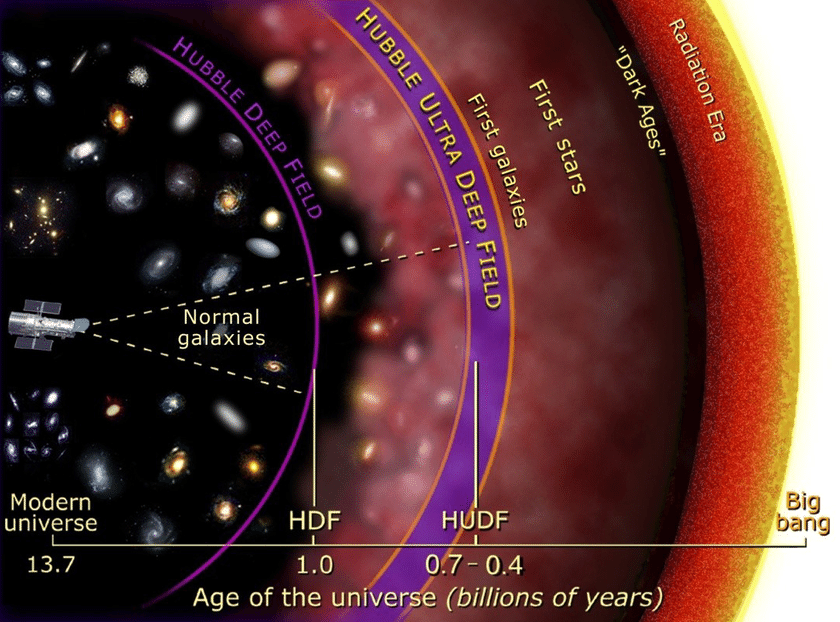About 13.8 billion years ago, The Universe as we know it began with a cataclysmic event known as the Big Bang.. Since then, space itself has expanded and cooled, the first particles have formed, and matter has been subjected to gravitational pull, giving rise to the vastness filled with planets, stars, and galaxies we see today.
But no matter how vast everything in space is, no matter how advanced and sophisticated our technology becomes, there is a limit to what we can see. Beyond a certain distance galaxies disappear, the stars are dimming and no trace of the distant Universe can be seen.
What’s beyond this? What would we find if we went as far into space as we can imagine? Would there be a limit to how far we could go, or would it be possible to travel an unlimited distance? In other words, does the Universe have an edge? If so, where?
What lies beyond the Solar System?
Space around the Solar System is full of stars. But if we go further than 100,000 light-years, we will leave the Milky Way behind and enter the intergalactic world so huge and impressive. Inhabited by approximately 2 trillion galaxies in our observable Universe alone.

The types, shapes, sizes and masses of these galaxies are very diverse. But when we look at the most distant galaxies, we begin to discover something unusual: The further away a galaxy is, the more likely it is to be smallerit has lower mass and its stars are inherently bluer than the nearest galaxies.
This makes perfect sense to modern science because of a relatively simple fact: The universe had a beginning. It’s a relatively nearby galaxy, almost the same age as ours. However, when we look at a galaxy billions of light years away, that light has to travel billions of years to reach our eyes.
Therefore, the further we look, the further back in time we can see the first galaxies to form.
When we look beyond the first galaxies, we expect the first stars to be followed by nothing but neutral gas. A time when the universe has not yet had enough time to pull matter into states dense enough to form a star.
Big Bang, Birth of the Universe
In the first few thousand years of the universe, radiation was so hot that neutral atoms could not form, causing photons to constantly bounce off surrounding particles.
Once neutral atoms were formed, photons could finally flow freely, unaffected by anything other than the expansion of the universe. The afterglow of this event, called the Cosmic Background Radiation, was definitive confirmation of the Big Bang.

Whichever direction we look in space, we see the same cosmic story: In our immediate surroundings are the stars and galaxies we know today; Previously, galaxies were smaller, bluer, younger and less developed; before that there were the first stars, and even before that, until the Big Bang, there were only neutral atoms, ionized plasma, free protons and neutrons, free quarks and gluons.
These definitions What we call the observable Universe, with a theoretical radius of about 46 billion light-years from Earth. But this is not a real limit in space: it is just a limit in time, a limit on what we can see, because the speed of light only allows information to travel for 13.8 billion years since the Big Bang. It is important to note that the value of the observable radius is greater than 13.8 billion light years, as the structure of space expands over time.
But after all, where is the limit of the Universe?
To finally answer our first question, it is necessary to understand that there is nothing special about our position in either space or time.
The fact that we can see 46 billion light years away it does not make it an ultimate limit or the location of something special in the CosmosIt’s like a ledge where we can stick our heads out and see what’s there. This just marks the limit of what we can see.

There are no edges in the universe. In other words, we can say that only the observable part of the universe has a finite volume and the reason for this is that there is a boundary in time (the Big Bang) that separates us from others.
We can only approach this limit through astronomical observations and physical theories, which are our best tools for probing the secrets of the cosmos.
Source: Tec Mundo
I’m Blaine Morgan, an experienced journalist and writer with over 8 years of experience in the tech industry. My expertise lies in writing about technology news and trends, covering everything from cutting-edge gadgets to emerging software developments. I’ve written for several leading publications including Gadget Onus where I am an author.













